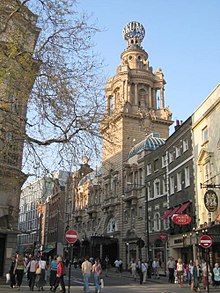Wikipedia
This text was copied from Wikipedia on 26 July 2024 at 6:10AM.
This article needs additional citations for verification. (February 2011) |

St Martin's Lane is a street in the City of Westminster, which runs from the church of St Martin-in-the-Fields, after which it is named, near Trafalgar Square northwards to Long Acre. At its northern end, it becomes Monmouth Street. St Martin's Lane and Monmouth Street together form the B404.
History
The street was first built up in 1610 when Robert Cecil, 1st Earl of Salisbury was granted 5 acres (2.0 ha) of land on the street's west side. It was originally known as West Church Lane; the current name dates from 1618.[1]
A narrow street with relatively little traffic, St Martin's Lane is home to the English National Opera at the Coliseum Theatre, as well as two other theatres, the Duke of York's Theatre[1] and the Noël Coward Theatre, second-hand bookshops, antique dealers and high class gentlemen's outfitters. It also has a large number of cafes and a music shop aimed at opera and theatre goers. The theatrical agency set up by Peggy Ramsay in 1953 was located in Goodwin's Court, an alley leading off the lane. Two pedestrian alleys, St Martin's Court and Cecil Court, connect St Martin's Lane with Charing Cross Road have similar usage.
In the 18th-century St Martin's Lane was noted for the Academy founded by William Hogarth[1] and later for premises of cabinet-makers and "upholsterers" such as Thomas Chippendale, who moved to better premises there in 1753, Vile and Cobb, and William Hallett around the corner in Newport Street.
The Salisbury
The Salisbury in Covent Garden was built as part of a six-storey block around 1899 on the site of an earlier pub that had been known under several names, including the Coach & Horses and Ben Caunt's Head; it is both Grade II listed, and on CAMRA's National Inventory, due to the quality of the etched and polished glass and the carved woodwork.[2]
Films
The film St Martin's Lane (also known as Sidewalks of London, 1938) starring Vivien Leigh, Rex Harrison and Charles Laughton, later formed the basis of the Broadway musical Busker Alley. The street is also prominently featured throughout the 1961 film Victim, which also has scenes in the Salisbury.
References

Citations
- ^ a b c Weinreb et al. 2008, p. 786.
- ^ "Heritage Pubs, National Inventory". www.heritagepubs.org.uk. Archived from the original on 22 July 2011. Retrieved 16 February 2011.
Sources
- Weinreb, Ben; Hibbert, Christopher; Keay, John; Keay, Julia (2008). The London Encyclopaedia (2nd ed.). Pan Macmillan. ISBN 978-1-405-04924-5.
51°30′38″N 0°07′38″W / 51.51056°N 0.12722°W / 51.51056; -0.12722

4 Annotations
First Reading
language hat • Link
St Martin's Lane
Runs north from Charing Cross, past St Martin's Church. A description of the lane a century before Pepys's time can be read here:
http://www.history.rochester.edu/…
1746 map here; click on Charing Cross in the list at the left (I think there's a way to link to individual segments but I don't know how):
http://www.motco.com/map/81002/
Second Reading
Bill • Link
Martin's (St.) Lane, Charing Cross, a street extending from Long Acre to Trafalgar Square; built circ. 1613, and then called "the West Church Lane." It is written "St. Martin's Lane" for the first time in the rate-book of St. Martin's in the year 1617-1618; but in 1608 a Treasury Warrant was issued to pay £100 towards making a vault [or sewer] for draining, etc., from St. Martin's Lane as far as St . Giles, so that the King's passage "through these fields shall be both sweeter and more commodious." The upper part was originally called the Terrace.
---London, Past and Present. H.B. Wheatley, 1891.
Terry Foreman • Link
St Martin's Lane runs from Charing Cross north, past St Martin's church
http://www.motco.com/map/81002/Se…
San Diego Sarah • Link
https://www.pepysdiary.com/diary/…
Tuesday 16 July 1667
✹ Terry Foreman on 16 Jul 2010 • Link • Flag
Brodrick to Ormonde
Written from: [London] Date: 16 July 1667
Communicates particulars of the Duke of Buckingham's release from the Tower: of his continuance "at his Lady's lodgings in St. Martin's Lane"; and of his preparations "to remove, with great equipage, to Wallingford-House, against the [meeting of] Parliament".
His Lady is presumably Mary Fairfax, Countess of Buckingham. I wonder why she kept a separate establishment from the Duke?